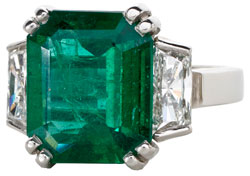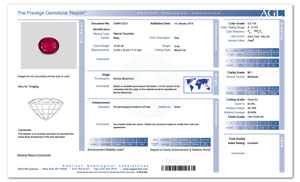A tale from the Caribbean
This is the story of an emerald that jumped 14 times in value in a few short months!
Would you believe it?
The short story:
A consumer purchased an emerald ring for $9,850. Eight months later he applied for insurance, presenting an appraisal that valued the piece at $140,000.
The deeper story:
A "Certificate of Authenticity" appraised the ring at its selling price of $9,850. The underwriter was skeptical because:
- The certificate came from the retailer—and sellers have an interest in overstating value and concealing quality.
- The appraiser was not named, the signature was illegible, and there was no indication of the appraiser's qualifications. An insurer wants an appraisal from a qualified appraiser independent of the seller.
- The cert carried only a cursory description of the ring—a white gold ring with a 10-carat green emerald and diamonds. Color is of prime importance in valuing colored gems, and color must be described using specific gemological language for tone, saturation and hue. "Green emerald" is not enough.
- The ring was purchased in Nassau. This was a major red flag, as tourist spots are notorious for overcharging unsuspecting vacationers. See our earlier story on Cruise Jewelry.
The underwriter asked for an appraisal from a GIA Graduate Gemologist, with a complete description of the ring.
EMERALD RING
Purchase price: $9,850
Appraisal valuation: $140,000
What happened next:
The consumer returned with an appraisal from a local jeweler. The appraisal described the ring in some detail and valued it at $140,000! Now the underwriter really did a double take. What could account for this extraordinary difference in valuation?
- Did this ring from a Nassau tourist shop really hold a rare gem of extraordinary value? Not likely.
- Did the retailer not understand the high worth of his merchandise and accidentally give his customer a real bargain? Really not likely! In fact, a quick online search revealed several accusations of fraud against this retailer. Customers complained of rings sold as 14K gold that turned out to be gold-plated silver, and of a lower-quality diamond being substituted for the higher-value original when left for mounting.
- Typical frauds involve over-pricing gems or exaggerating quality, but this case seems to be just the opposite. Did this emerald somehow really jump to 14 times its value in just a few months? No, that just doesn't happen.
- Did the customer's local appraiser misjudge or misrepresent the quality of the emerald? This is the most probable explanation.
Most jewelers are acquainted primarily with diamonds because that is by far the most popular stone. Appraising a colored gem needs the expertise of an appraiser who is familiar with the market for colored stones, as well as with gem treatments, any current scams, and gem imitations. In this case, the appraiser's website offered custom-designed jewelry, diamond information, diamond appraisals, etc., but did not even mention colored stones.
The appraisal did not say whether the emerald was treated or untreated. Fracture-filling is a very common clarity treatment for emerald and it significantly affects the gem's value.
The appraisal did not say whether the stone was mined or lab-made. In nature, fine emeralds with few inclusions are very rare and extremely expensive. On the other hand, gem-growing labs can easily produce attractive, unincluded emeralds that sell at affordable prices.
This appraiser gave his credential as "GIA Gemologist," which is not the same as a GG. GIA offers many courses, but GG (Graduate Gemologist) represents the most complete training, requiring a specific course of study that includes both classes and laboratory work.
Finally, an emerald valued at $140,000 definitely requires a gem report from a reliable independent grading lab to verify its quality. The underwriter asked for a gem report from AGL (American Gemological Laboratories) with full stone information, including color and clarity grading, origin and treatments.
How important is a reliable lab report?
Suppose the customer above did not present to the insurer the document from the seller, which carried the $9,850 purchase price? Suppose the client presented only the appraisal valuing the ring at $140,000?
Would the underwriter think to ask for a sales receipt? Or would he trust the appraiser and accept the appraisal's valuation?
Would he ask for a lab report from a reliable independent lab, to substantiate the gem's quality? If not, the insurer could be in for a huge overpayment in the future.
FOR AGENTS & UNDERWRITERS
Appraisal documents from the retailer are suspect. Always seek an appraisal from a reliable appraiser independent of the seller.
Color is of prime importance in valuing emerald and other colored gems. The appraisal should have a detailed description in precise gemological language.
Not every jeweler, nor even every trained gemologist, is competent to appraise emeralds. A reliable appraiser is one who is experienced with colored gemstones and familiar with current pricing, treatments, and frauds. The appraiser should be a GG or FGA+, preferably also a Certified Insurance Appraiser™.
Fracture filling is so commonplace that emeralds NOT so treated are worth considerably more than treated stones. The appraisal should either note the treatments performed on the emerald or explicitly state that the stone is untreated.
The quality of a high-value gem should also be substantiated by a report from a respected independent lab. The most reliable labs are:
For colored gems:
AGL
FOR ADJUSTERS
Replace with like kind and quality. Rely on precise color and clarity descriptions.
In nature, fine emeralds with few inclusions are very rare and extremely expensive, while in the lab, attractive, unincluded emeralds can easily be synthesized and sold at affordable prices.
Terms such as lab-grown, man-made, created, and cultured mean that the emerald is synthesized. Lab-made gems have considerably lower value than mined gems of the same quality.
Look carefully at the appraisal and other documents for words like treated, enhanced, fracture-filled and laser-drilled. This is crucial information when pricing a replacement.
Fracture filling is so commonplace in the emerald market that stones NOT so treated are worth considerably more than treated stones. Do not consider an emerald as untreated unless the appraisal specifically states that it is.
Because fracture filling is so common, have all damaged emerald jewelry examined in a gem lab by a Certified Insurance Appraiser™.
Breakdown of a fracture-filling treatment is not considered damage for which the insurer is liable.
©2000-2025, JCRS Inland Marine Solutions, Inc. All Rights Reserved. www.jcrs.com



